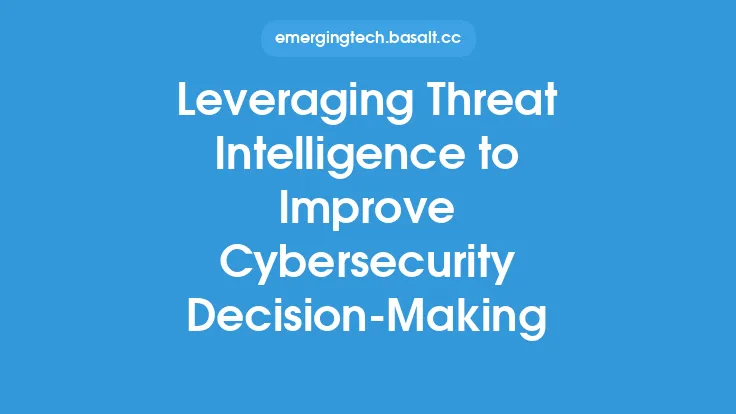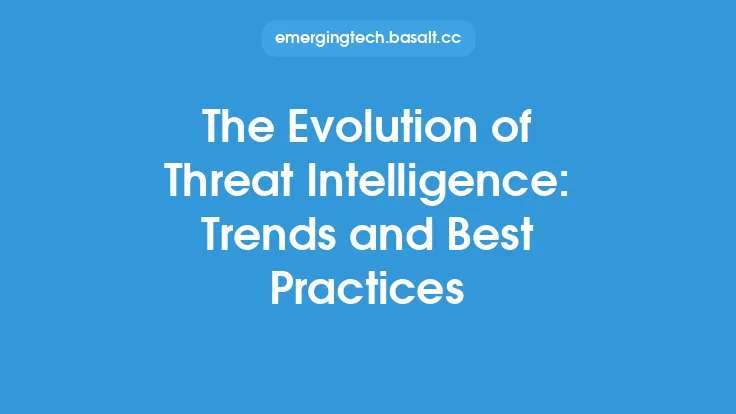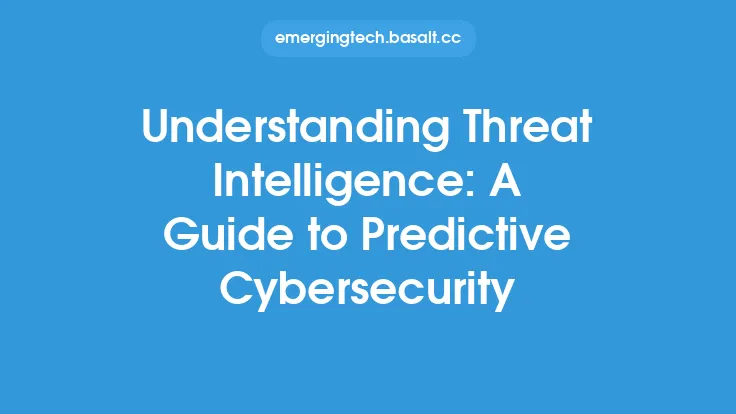In the realm of cybersecurity, staying ahead of emerging threats is a constant challenge. As technology advances and new vulnerabilities are discovered, the threat landscape evolves, making it essential for organizations to be proactive in their defense strategies. Threat intelligence plays a crucial role in this endeavor, providing valuable insights into potential threats and enabling organizations to take informed decisions to mitigate them. At its core, threat intelligence is the process of gathering, analyzing, and disseminating information about potential or existing threats to an organization's security. This information can come from various sources, including open-source intelligence, human intelligence, and technical intelligence.
What is Threat Intelligence?
Threat intelligence is a subset of cybersecurity that focuses on understanding the tactics, techniques, and procedures (TTPs) used by threat actors. It involves collecting and analyzing data from various sources to identify patterns, trends, and anomalies that could indicate a potential threat. Threat intelligence can be categorized into three main types: strategic, tactical, and operational. Strategic threat intelligence provides a high-level overview of the threat landscape, focusing on the motivations and goals of threat actors. Tactical threat intelligence focuses on the TTPs used by threat actors, while operational threat intelligence provides real-time information on ongoing attacks or campaigns.
Sources of Threat Intelligence
Threat intelligence can be gathered from various sources, including open-source intelligence, human intelligence, and technical intelligence. Open-source intelligence refers to information that is publicly available, such as social media posts, news articles, and online forums. Human intelligence, on the other hand, involves gathering information from human sources, such as interviews, surveys, and undercover operations. Technical intelligence refers to information gathered from technical sources, such as network traffic, system logs, and malware analysis. Additionally, threat intelligence can be gathered from commercial sources, such as threat intelligence feeds, and from government agencies, such as law enforcement and intelligence agencies.
The Threat Intelligence Lifecycle
The threat intelligence lifecycle refers to the process of gathering, analyzing, and disseminating threat intelligence. It involves several stages, including planning and direction, collection, processing, analysis, dissemination, and feedback. The planning and direction stage involves defining the scope and objectives of the threat intelligence effort. The collection stage involves gathering data from various sources, while the processing stage involves filtering and categorizing the data. The analysis stage involves examining the data to identify patterns, trends, and anomalies, while the dissemination stage involves sharing the intelligence with relevant stakeholders. The feedback stage involves refining the intelligence based on feedback from stakeholders and updating the intelligence to reflect new information.
Threat Intelligence Tools and Techniques
Several tools and techniques are used in threat intelligence, including threat intelligence platforms, security information and event management (SIEM) systems, and malware analysis tools. Threat intelligence platforms provide a centralized repository for storing and analyzing threat intelligence, while SIEM systems provide real-time monitoring and analysis of network traffic and system logs. Malware analysis tools, such as sandboxing and reverse engineering, are used to analyze and understand the behavior of malware. Additionally, techniques such as anomaly detection, predictive analytics, and machine learning are used to identify patterns and trends in the data.
Benefits of Threat Intelligence
Threat intelligence provides several benefits to organizations, including improved incident response, enhanced risk management, and better decision-making. By providing real-time information on potential threats, threat intelligence enables organizations to respond quickly and effectively to incidents, reducing the impact of a breach. Threat intelligence also enables organizations to prioritize their security efforts, focusing on the most critical vulnerabilities and threats. Additionally, threat intelligence provides valuable insights into the threat landscape, enabling organizations to make informed decisions about their security strategies and investments.
Challenges and Limitations of Threat Intelligence
Despite its benefits, threat intelligence faces several challenges and limitations, including data overload, information sharing, and analyst expertise. The sheer volume of data available can be overwhelming, making it difficult to identify relevant information. Information sharing between organizations and agencies can be limited due to concerns about confidentiality and liability. Additionally, threat intelligence requires specialized expertise, including knowledge of threat actor TTPs, malware analysis, and network traffic analysis. Furthermore, threat intelligence is not a one-time effort, but rather an ongoing process that requires continuous monitoring and analysis to stay ahead of emerging threats.
Best Practices for Implementing Threat Intelligence
Several best practices can be followed to implement threat intelligence effectively, including defining clear objectives, establishing a threat intelligence team, and integrating threat intelligence into existing security processes. Clear objectives should be defined to focus the threat intelligence effort, while a dedicated team should be established to gather, analyze, and disseminate threat intelligence. Threat intelligence should be integrated into existing security processes, such as incident response and risk management, to provide a comprehensive security posture. Additionally, threat intelligence should be continuously monitored and updated to reflect new information and emerging threats.
Conclusion
Threat intelligence is a critical component of cybersecurity, providing valuable insights into potential threats and enabling organizations to take informed decisions to mitigate them. By understanding the sources, tools, and techniques of threat intelligence, organizations can implement effective threat intelligence programs to stay ahead of emerging threats. While threat intelligence faces several challenges and limitations, following best practices and continuously monitoring and updating threat intelligence can help organizations to overcome these challenges and improve their security posture. As the threat landscape continues to evolve, threat intelligence will play an increasingly important role in helping organizations to protect themselves against cyber threats.





